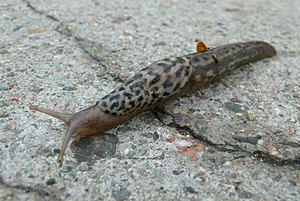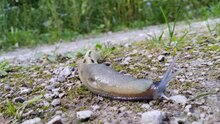Limax
| Limax | ||||||||||||
|---|---|---|---|---|---|---|---|---|---|---|---|---|

Tiger snail ( Limax maximus ) |
||||||||||||
| Systematics | ||||||||||||
|
||||||||||||
| Scientific name | ||||||||||||
| Limax | ||||||||||||
| Linnaeus , 1758 |
Limax is the type - species of slugs family of the slug (Limacidae) from the suborder of terrestrial gastropods (Stylommatophora). Some of the species that were originally only native to Europe, West Asia and North Africa have now been introduced worldwide by humans.
features
They are medium to large nudibranchs; the tiger's snail ( Limax maximus ) reaches a body length of up to 200 mm. The coat is relatively small in relation to its length and lies in the front half of the body. It has fine concentric furrows, the center of which is roughly in the middle of the mantle shield. The breathing hole is behind the middle of the mantle shield on the right side of the body. The genital opening is located between the breathing hole and the right tentacle. The rear part of the body is keeled; but this does not extend to the rear edge of the mantle. The housing is reduced to a small plate, which is mostly shifted slightly to the left half of the body and completely enclosed by the jacket.
The species are differently colored and z. T. drawn more or less conspicuously. Some species also show a strong intraspecific variability in coloration and drawing. The penis and retractor muscles of the right antennae cross each other in the genital apparatus. The penes are usually long and cylindrical, often reaching several times the length of the body, e.g. Sometimes also short and rather spherical. The penile retractor muscle attaches to the back of the organ. The intestine has three loops, of which the first or third loop extend farthest back; some species also have an appendix.
Geographical distribution and habitat
The Limax species were originally native to Europe, North Africa and West Asia. One species was recently described from Nepal. but in the meantime some (a few) species have been introduced almost worldwide. Due to the spreading with cultivated plants and commercial goods, the original range of some species is difficult to develop.
Most Schnegel species are rare animals that mainly occur in natural landscapes, but also in cultural landscapes , in gardens, parks and basements. The range of some species is also very limited. They are mainly fungus, lichen, algae and scavengers, or they eat dead, less often fresh plant material. Hardly any species of snails is currently known that builds populations that are so large in their original range that useful plants are damaged. In regions to which they have been carried off by humans, they can cause greater damage in crops and gardens than neozoa .
Taxonomy
The taxon was first described by Carl von Linné in 1758 in the 10th edition of the Systema Naturae.
For some species of the genus there is still uncertainty about the status and relationship. Anatomical and external features are mostly insufficiently described for a reliable determination. A genetic analysis is often the only way to clearly differentiate the species. New species of the Limax genus are still being discovered, especially in Corsica, in the Alps and in the mountains of southern Europe. Since many biotopes are being destroyed in southern Europe in particular, there is a risk that some species will be lost to extinction before they are discovered. Species with a small range are also endangered. In the meantime, species that used to be very common and perceived as pests have now become rare due to improved stockpiling and storage of food.
Most authors subdivide the genus Limax into two or three sub-genera: Limax (Limax) Lamarck, 1801 and Limax (Kasperia) Godwin-Austen, 1914 and Limacus , which is partly classified as a subgenus of Limax and partly as an independent genus. In 2008 Falkner & Niederhöfer proposed the subgenus Limax (Brachylimax) with the type species Limax (Brachylimax) giovannellae .
The following species are currently included in the genus Limax (Limax) :
- Limax aeolianus Giusti 1973
- White-sole snail ( Limax albipes Dumont & Mortillet, 1853) (unsafe species)
- Limax alpinus Férussac, 1821 (? = L. sarnensis Heim & Nitz, 2009)
- Limax amaliae Bettoni, 1870
- Limax bielzii Seibert, 1873
- Limax bivonae Lessona & Pollonera, 1882
- Limax brandstetteri Falkner, 2008
- Limax camerani Lessona & Pollonera, 1882
- Limax canapicianus Pollonera, 1885
- Limax cephalonicus Simroth, 1886
- Limax ciminensis Pollonera, 1890
- Black Schnegel ( Limax cinereoniger Wolf, 1803)
- Limax conemenosi Böttger, 1882
- Corsican snail ( Limax corsicus Moquin-Tandon, 1855)
- Limax cruentus Lessona, 1880
- Limax dacampi Menegazzi, 1854
- Limax dobrogicus Grossu & Lupu, 1960
- Limax doriae Bourguignat, 1861
- Limax ecarinatus Boettger, 1881
- Limax engadinensis (Heynemann, 1863)
- Limax erythrus Bourguignat, 1864
- Limax genei Lessona & Pollonera, 1882
- Limax geographicus Ferussac, 1823
- Limax gerhardti Niethammer, 1937
- Limax giovannellae Falkner & Niederhofer, 2008
- Limax giustii Falkner & Nitz, 2010
- Limax graecus Simroth, 1889
- Limax granosus Berenguier, 1900
- Limax graziadeii Gerhardt, 1940
- Limax hemmeni Rähle, 1983
- Limax ianninii Giusti, 1971
- Limax illyricus Simroth, 1907
- Limax ilvensis Falkner & Nitz, 2010
- Limax lachensis Berenguier, 1900
- Limax luctuosus Moquin-Tandon, 1855
- Limax macedonicus Hesse, 1928
- Limax martinianus Bourguignat, 1869
- Tiger snail ( Limax maximus Linnæus, 1758)
- Limax millipunctatus Pini, 1884
- Limax monregalensis Lessona & Pollonera, 1884
- Limax montanus Leydig, 1871
- Limax perosinii Lessona & Pollonera, 1882
- Limax pironae Pini, 1876
- Limax polipunctatus Pollonera, 1888
- Limax psarus Bourguignat, 1861
- Limax punctulatus Sordelli, 1871
- Limax redii Gerhardt, 1933
- Sarner Schnegel ( Limax sarnensis Heim & Nitz, 2009) (? = L. alpinus Férussac, 1823)
- Limax senensis Lessona & Pollonera, 1882
- Limax seticus Wiktor & Bössneck, 2004
- Limax sordidus Lessona & Pollonera, 1882
- Limax squamosus Berenguier, 1900
- Limax strobeli Pini, 1876
- Limax subalpinus Lessona, 1880
- Limax tschapecki Simroth, 1886
- Limax veronensis Lessona & Pollonera, 1882
- Limax vizzavonensis Falkner & Nitz, 2010
- Limax arguably Simroth, 1900
- Limax wolterstorffi Simroth, 1900
- Limax zilchi Grossu & Lupu, 1960
The subgenus Limax (Kaspersia) currently contains only one species:
- Limax turkestanus Simroth, 1898.
The subgenus Limax (Brachylimax) Falkner & Niederhöfer, 2008 is currently also (still) monotypical:
- Limax giovannellae Falkner & Niederhöfer, 2008.
supporting documents
literature
- Klaus Bogon: Land snails biology, ecology, biotope protection. 404 p., Natur Verlag, Augsburg 1990 ISBN 3-89440-002-1
- Rosina Fechter and Gerhard Falkner: molluscs. 287 pp., Mosaik-Verlag, Munich 1990 (Steinbach's Nature Guide 10), ISBN 3-570-03414-3
- Jürgen H. Jungbluth and Dietrich von Knorre: Common names of land and freshwater mollusks in Germany (Gastropoda et Bivalvia). Mollusca, 26 (1): 105-156, Dresden 2008 ISSN 1864-5127 PDF
- Michael P. Kerney, RAD Cameron & Jürgen H. Jungbluth: The land snails of Northern and Central Europe. 384 pp., Paul Parey, Hamburg & Berlin 1983, ISBN 3-490-17918-8
- Anatolij A. Schileyko: Treatise on Recent Terrestrial Pulmonate Molluscs Part 11 Trigonochlamydidae, Papillodermidae, Vitrinidae, Limacidae, Bielziidae, Agriolimacidae, Boettgerillidae, Camaenidae. Ruthenica, Supplement 2 (11): 1467-1626, Moscow 2003, ISSN 0136-0027
- Andrzej Wiktor: The Polish Nudibranchs. 182 p., Monograph Fauny Polski, Polska Akademia Nauk Zakład Zoologii Systematycznej i Doświadczalnej, Warsaw & Kraków 1973.
Individual evidence
- ^ Wiktor, Andrzej & Ulrich Bößneck 2004: Limax (Limax) seticus n.sp. from high mountains in Nepal (Gastropoda: Pulmonata: Limacidae). Folia Malacologica, 12, 183-187.
- ↑ Linnæus, Carolus 1758: Systema naturæ per regna tria naturæ, secundum classes, ordines, genera, species, cum characteribus, differentiis, synonymis, locis. Tomus I. Editio decima, reformata. Pp. 1-824, Stockholm (Holmiæ), Salvius. Online at Göttingen Digitization Center (p. 652)
- ↑ Annual report of the Natur-Museum Luzern (PDF; 1.0 MB), 2006, p. 14.
- ↑ Naturforschende Gesellschaft Luzern, Schatzinsel Alp Lix ( Memento of the original from May 16, 2005 in the Internet Archive ) Info: The archive link has been inserted automatically and has not yet been checked. Please check the original and archive link according to the instructions and then remove this notice. , accessed February 9, 2008
- ↑ From the Bavarian State Natural Science Collections ( page no longer available , search in web archives ) Info: The link was automatically marked as defective. Please check the link according to the instructions and then remove this notice. , Annual Booklet 2006, p. 5
- ↑ Falkner, Gerhard & Hans-Jörg Niederhöfer 2008: Limax ( Brachylimax n. Subg.) Giovannellae n. Sp., A sex-biologically defined subgenus and a new species from the Julian Alps (Gastropoda: Limacidae). With a photo documentation by Clemens M. Brandstetter. Club Conchylia Informations, 39 (1/2): 7–19, back cover, Ludwigsburg.
- ↑ Fauna Europaea - genus Limax
- ^ AnimalBase - Limax
- ↑ Biljana Telebak, Miloje Brajković, Srećko Ćurčić: Contribution to the knowledge of the slugs (Gastropoda: Stylommatophora: Limacidae and Milacidae) from Montenegro. Bulletin of the Natural History Museum, 2013, 6: 55-64. doi: 10.5937 / bnhmb1306055T PDF
- ^ Andrzej Wiktor: Taxonomic position of Kasperia Godwin-Austen, 1914 (Gastropoda: Pulmonata: Limacidae). Folia Malacologica, 9 (1): 37-38, Krakow 2001 ISSN 1506-7629
